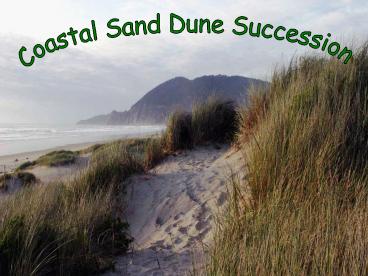Coastal Sand Dune Succession - PowerPoint PPT Presentation
1 / 18
Title:
Coastal Sand Dune Succession
Description:
In a plant free landscape (e.g. after a land or lava flow, a fresh sandy ... March species develop, along with peat in the waterlogged soil. ... – PowerPoint PPT presentation
Number of Views:1932
Avg rating:3.0/5.0
Title: Coastal Sand Dune Succession
1
Coastal Sand Dune Succession
2
Coastal Dunes
- In a plant free landscape (e.g. after a
landslide or lava flow, a fresh sandy coastline,
or derelict industrial wasteland) plants become
established over a number of years and move from
the pioneer stage through succession to mature
climax community of stable vegetation.
3
Remember your terms
- Plant successionchanges in plant community in an
ecosystem over a period of time. - Climax vegetationwhen a plant succession has
reached a balance in vegetation, soil and climate
Often with coastal dune questions part i) will
ask you to define one of these terms.
4
The only such environment that will appear in the
higher exam will be succession across a sand dune
coast.
- A coastal environment is a very harsh
environment for plants to survive in. As you move
inland, 200 metres or so from the high water
mark, you pass through a number of zones. - You need to be able to
- describe how the physical conditions alter as
you move inland, - and explain why the plants have adapted to the
subtle changes in the environment.
5
Formation of Sand Dunes
- Where there is large supply of dry sand (for
example, on a sandy beach exposed by the tide and
heated by the sun), together with winds having a
speed greater than 15 kph, the sand will be
picked up and blown by the wind. - Plants growing on the shore-line provide mini-
wind breaks which slow the wind down in their
immediate vicinity. If the wind is slowed
sufficiently, it will drop some of its cargo of
sand. A sand pile will begin to accumulate at
this point, providing an ever increasing wind
break. Eventually the sand pile will grow into a
dune at the back of the beach.
6
With high wind speeds, the sand is continually
pushed over the crest of the dune, falling down
the steeper windward slope. This has the effect
of causing the dune to move steadily inland.
Pioneer plants will begin to colonize the dunes,
gradually holding the sand in one place with
their root networks. New sand dunes may build up
behind the first dune, eventually forming a
series of dunes from the seashore, inland.
7
Stages in succession along a coastal sand dune
- There are 5 main stages in succession across a
coastal sand dune - Stage 1 Embryo Dune
- Stage 2 Yellow (Main) Dune
- Stage 3 Semi fixed Dune
- Stage 4 Grey/fixed Dune
- Stage 5 Climax Vegetation
8
Stage 1 Embryo Dune
- Strandline a line of seaweed litter and debris
along the high tide mark which provides nutrients
for sea rocket and couch.
9
(No Transcript)
10
Stage 2 Yellow (Main) Dune
As pioneer plants grow they provide shelter for
the thin humus layer which is being formed by the
decomposition of the pioneer biota. The
environment here is still very harsh though, and
only very hardy plants can survive, such as
Marram Grass.
11
(No Transcript)
12
Stage 3 Semi fixed Dune
- At around 10m above sea level, the marram
grass dies out as the sand supply is reduced,
meaning a thin humus layer is now permanent and
soil can form. - Improved conditions and increased moisture
content leads to a greater variety of vegetation
type.
13
A greater variety of plants can now be supported,
including dandelion, ragwort and rest harrow.
14
Stage 4 Grey/fixed Dune
- With the increasing variety of plants, the
soil becomes deeper and more fertile and can
support an almost complete covering of
vegetation. Typical plants Mosses and Lichens,
Clover and herbs such as Red Fescue.
15
(No Transcript)
16
Stage 5 Climax Vegetation
- When a dune succession reaches its climax
stage, the vegetation found largely depends on
the mineral composition of the sand. - Calcareous (alkaline,shell based)
- rich grassland
- Silica (acidic rock fragments)-
- heath land then deciduous tress
17
(No Transcript)
18
Slacks
- Low lying areas in between dunes (found at
all stages in the succession). These are often
marshy due to rise in water table. March species
develop, along with peat in the waterlogged soil.































